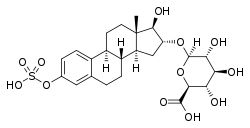Estriol sulfate glucuronide
Estriol sulfate glucuronide, or estriol 3-sulfate 16α-glucuronide, is an endogenous, naturally occurring diconjugated metabolite of estriol.[1] It is generated in the liver from estriol sulfate by UDP-glucuronyltransferase and is eventually excreted in the urine by the kidneys.[1] It occurs in high concentrations during pregnancy along with estriol sulfate and estriol glucuronide,[2] and was a component of the early pharmaceutical estrogens Progynon and Emmenin.[3][4][5][2]
 | |
| Names | |
|---|---|
| IUPAC name
(2S,3S,4S,5R)-3,4,5-Trihydroxy-6-{[(1S,10R,11S,13R,14R,15S)-14-hydroxy-15-methyl-5-(sulfooxy)tetracyclo[8.7.0.0²,⁷.0¹¹,¹⁵]heptadeca-2(7),3,5-trien-13-yl]oxy}oxane-2-carboxylic acid | |
| Other names
Estriol 3-sulfate 16α-glucuronide; 17β-Hydroxy-3-(sulfooxy)estra-1,3,5(10)-trien-16α-yl-β-D-glucopyranosiduronic acid | |
| Identifiers | |
CAS Number |
|
3D model (JSmol) |
|
| ChemSpider | |
PubChem CID |
|
InChI
| |
SMILES
| |
| Properties | |
Chemical formula |
C24H32O12S |
| Molar mass | 544.57 g·mol−1 |
Except where otherwise noted, data are given for materials in their standard state (at 25 °C [77 °F], 100 kPa). | |
| Infobox references | |
References
- http://www.hmdb.ca/metabolites/HMDB10356
- N. S. Assali (3 September 2013). The Maternal Organism. Elsevier. pp. 339–. ISBN 978-1-4832-6380-9.
- Thom Rooke (1 January 2012). The Quest for Cortisone. MSU Press. pp. 54–. ISBN 978-1-60917-326-5.
- Gregory Pincus (22 October 2013). Recent Progress in Hormone Research: The Proceedings of the Laurentian Hormone Conference. Elsevier Science. pp. 307–. ISBN 978-1-4832-1945-5.
- Robert K. Creasy; Robert Resnik; Charles J. Lockwood; Jay D. Iams; Michael F. Greene; Thomas Moore (2013). Creasy and Resnik's Maternal-Fetal Medicine: Principles and Practice. Elsevier Health Sciences. pp. 104–. ISBN 978-1-4557-1137-6.
External links
This article is issued from
Wikipedia.
The text is licensed under Creative
Commons - Attribution - Sharealike.
Additional terms may apply for the media files.